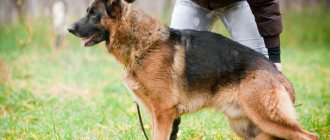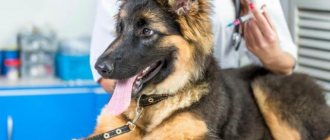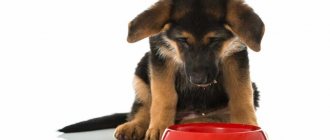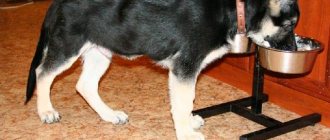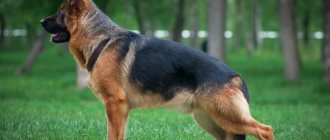Germans are the smartest breed of dogs, which are adopted not only as a loyal friend, but also as a guard and protector of the home. The conditions for keeping a pet depend on where its owner lives - in a city apartment or in a private house. In order for both the dog and the person to feel comfortable, it is important to follow certain rules. Further in the article, how to keep a German shepherd at home and in an apartment, what are the differences between street and indoor living of a pet, as well as how to properly care for the four-legged health.
Is it worth keeping a “German” in an apartment?
Before answering the question “is it worth keeping a German Shepherd in an apartment?”, consider the character and size of this breed. It is known that this is a freedom-loving, calm, very intelligent animal with a balanced psyche. If we talk about build, then this is a fairly large and powerful dog with voluminous muscles and hair.
It is clear that she will be very uncomfortable in a one-room apartment, and there is no point in keeping a shepherd dog in a tight confined space. If the owner has a larger apartment, then you can already think about having the pet live in the apartment. Of course, this phenomenon has both pros and cons that should be taken into account before getting a shepherd dog in such a home. Let's look at the main advantages:
- The pet will be an excellent guard against uninvited guests.
- The Shepherd gets along well with children, she will take care of them and is easily able to play the role of a nanny.
- Such a dog easily gets used to difficult living conditions and is unpretentious to them.
Now let's talk about the disadvantages:
- Since German Shepherds shed quite a bit, owners need to be prepared for a lot of hair on the floor and furniture.
- If your pet is not walked at least twice a day, he will have nowhere to put the energy that has accumulated from sitting in a cramped space.
- Since this breed is very loyal to its owners, the dog should not be left alone for a long time. If this happens, the animal’s psyche will simply be shaken.
Description of the exterior of the German Shepherd
German shepherds belong to large working breeds, but these dogs weigh no more than 40 kg, and their height reaches 60 cm. Therefore, they are sometimes classified as medium breeds. They have distinct differences between males and females: the former are larger and have strong bones. But all representatives of the breed have powerful muscles and a proportional physique. This is clearly noticeable in any photograph.
Standards
The modern breed standard was adopted in 1996. The description of the shepherds has not changed much, but some minor amendments have been made. The weight of a male German Shepherd should be 30-40 kg. Deviations of more than 1 kg are not allowed. Females weigh less - from 22 to 32 kg. The height at the withers of a male German Shepherd is 60-65 cm, the height of a female is 55-60 cm.
Head
The head is large, but proportional to the body. The proportions between the muzzle and the skull are 1:1. The shape is wedge-shaped, not very wide. The nose is level, with a slight smooth stop. The lobe is large, always black. The jaws are powerful, with a scissor bite. Lips fit tightly.
The ears are pointed, triangular, set high. They are large, mobile, open forward. They are usually erect, but in the long-haired variety they are semi-hanging. The eyes are deep, brown in color, widely and slightly slanted. The look is smart and attentive.
Torso
The German Shepherd is a dog with a strong build and powerful, toned muscles. The neck is smooth and muscular, the chest is massive and deep. The line of the back decreases towards the croup. The back is wide and strong. This is clearly noticeable in the profile photo of the dog.
The tail is long, set low, and saber-shaped. When the dog is calm, it is lowered, but the tip is usually curved upward. Even in short-haired varieties it is fluffy.
Limbs
The forelimbs are straight, set parallel. Elbows are pressed. The hind legs are slightly set back, the lower leg and thigh are of equal length. The paws are round and compact. They spring well when moving.
Wool
The German Shepherd has a thick, coarse coat with a dense undercoat. More dense fur on the neck, paws and tail. There are two types of the breed: short-haired and long-haired. The first is the classic variety; in Germany only such dogs are recognized. They have thick fur that does not puff up, but fits tightly.
The difference between long-haired shepherd dogs is that they have soft hair and an equally dense undercoat, but they tolerate cold worse than short-haired dogs. The undercoat is also dense and dense. Feathers and a bushy tail appear on the ears and paws. They are rarely used as service dogs, as they have a more nervous character.
Color
German Shepherds can come in several colors. There are three recognized standards: gray-black, yellow-black and pure black. Among them there are many types.
- The most common color is called saddle cloth. Black-backed dogs seem to have a black mantle on their back. It covers the back, the upper part of the tail. A black mask is required on the face. The underparts of black-backed dogs are usually red or fawn, but can be grey, chocolate or off-white.
- Black German Shepherds are rare, only 5%. This color is rich, without splashes of white or other colors.
- The zonal color may have a gray or red tint. It is similar to the saddleback, but less black - only darkening on the back and face.
Having looked at the photographs, you can understand what color a proper shepherd dog should have, since it is difficult to imagine from the description.
German Shepherd, shabby color
Black German Shepherd
Zone color
Deviations from the standard
Any deviations from the standard are considered deficiencies. Such dogs are not allowed for breeding and participation in exhibitions. There are several most common faults that a proper German Shepherd should not have:
- white color, common only in America;
- completely red or gray color is not recognized at all;
- inclusions of other colors in black dogs;
- short stature - the dwarf German shepherd is not officially recognized, although there are many fans of this variety in the world;
- deviations from height and weight standards;
- low set ears;
- not a scissor bite;
- long soft wool.
How to properly organize a place for your pet
If a person nevertheless decides to have a German shepherd in an apartment, he should know how to properly care for the animal and try to do everything to make the pet comfortable in such spartan conditions, because it is quite impressive in size.
The first thing you should pay attention to is organizing a place for the shepherd to sleep and rest. It is necessary not to change it throughout the dog’s life so that it clearly knows its boundaries. The bed should be located in a dry and warm place. It is necessary to exclude any drafts near the animal’s resting place, as this has a bad effect on its health. Also find out what the booth should be like if the dog lives in a private house.
A mattress covered with a sheet with an elastic band can be used as a bed so that it can be easily removed and washed. Pet stores also have special enclosures adapted for apartments. They have a design that seems to rise above the floor. Your pet will enjoy sitting in such an enclosure, because from it he can easily observe the entire area of the apartment. It is worth remembering that there should be no radiators or radiators near the pet’s sleeping place, and it should also be light.
Preparing to move
As soon as a puppy appears in your apartment, you can forget about the previous rhythm of life. Now you will have to face the fact that you will live with a playful pest that will chew on almost everything - from furniture to clothes and shoes.
If your baby eats your things, it won't be his fault. Before your toddler crosses the threshold of your home, remove anything that might attract his attention from his reach.
Stock up on toys so your pet doesn't get bored. Place detergents in a separate cabinet so that the dog cannot get to them. Put the wires in a secluded corner. Then your property will not be damaged, and the baby will not have digestive problems.
The animal must have its own inviolable territory in the apartment. Buy him a bed with a removable pillowcase to make it easier to keep clean. Place your dog's bed in the room where you most often spend time. The exception is the kitchen. There is no place for a puppy there. Do not violate the puppy's personal space. Where he rests, you cannot scold him or treat him. Here the baby should feel completely safe.
Nutrition
As for the food of the German Shepherd, in the apartment it can be of two types: natural, prepared at home, or ready-made from a pet store.
The main thing is that your pet’s diet should be strictly balanced and healthy. If the owner prepares food for the dog himself, then the menu should include the following products:
- Raw meat (about 60-70 percent of the entire serving),
- Boiled vegetables,
- Low-fat dairy products,
- Liver,
- Rice, buckwheat,
- Lean fish
- Sunflower and butter,
- Greenery,
- Fruits.
If the food is purchased, then it must meet quality standards and be specially adapted for the specific age of the dog. The food can be dry or wet. You can alternate it in the morning and evening. It is also necessary to ensure that your pet always has clean drinking water in his bowl.
Bathing and grooming
In terms of hygiene, German Shepherds are unpretentious. They need to be bathed 3-4 times a year, but not more often. The thing is that with frequent washing with shampoos, the fatty layer that protects it from various infections is washed off from the dog’s skin.
Of course, after a walk, the animal’s paws need to be washed well and wiped dry. If your pet has a strong specific odor, you can wash it with dog shampoo.
An animal like a shepherd often sheds. Therefore, when keeping her in an apartment, you need to comb out excess fur with a furminator or brush. Grooming a puppy or adult's coat should be done at least once a day.
Are vaccinations necessary?
Vaccination is a great way to avoid many diseases and further health problems for your animal.
They need to be done according to a specific schedule:
- The puppy is vaccinated against hepatitis, parvovirus and coronavirus enteritis at the age of 1.5 months, and two weeks later, as prescribed by the veterinarian, they are re-vaccinated;
- The puppy is vaccinated against canine distemper at three months, and again after 6 months;
- Vaccinated against leptospirosis at 4 months;
- At 6 months they are vaccinated against rabies and repeated every year.
The listed vaccinations must be done according to schedule, otherwise serious health problems cannot be avoided. There are also a number of vaccinations that owners do at will (vaccinations against microsporia, trichophytosis, parainfluenza).
Cleaning ears and teeth
The pet’s hearing organs and teeth are also something that you should pay attention to when hygienic procedures, caring for and keeping a German Shepherd in an apartment. It is necessary to constantly monitor the condition of the animal’s ears, especially when they are at the stage of raising and have not yet fully acquired the correct position. If there is any deviation, you need to take the dog to the veterinarian. The ear canal should be cleaned 2 times a week with cotton swabs, which must first be moistened in a chlorhexidine solution.
If your pet wears its nails down on the asphalt while walking, there is no need to trim them. But if this does not happen and the nails are in the way of the shepherd, they must be shortened with special scissors sold in pet stores.
Dispatch of natural necessities
Like any animal, a dog needs to relieve its natural needs while living in a city apartment. If the puppy is still small, you need to immediately teach him to do this outside. It is best to take your pet out early in the morning and in the evening. Of course, at first you will have to get up and take the dog out at night. But shepherd dogs are a very smart and understanding breed, so they quickly get used to sending their needs on the street, and not in the home.
Education and training
It doesn’t matter where the German Shepherd lives - in a city apartment or a country house. It is necessary and important to educate and train her. Otherwise, her talent for learning and mental abilities will simply disappear into the ground.
How to raise her correctly? It is necessary to begin training and education from a young age of the animal. A puppy can be trained from 2-3 months of its life. First of all, he must learn commands such as “place”, “sit”, “no”, “give me your paw”. You can send your pet to general training courses conducted by experienced dog handlers. This way the dog will quickly and easily receive proper training.
In addition, in order for the shepherd dog to get used to strangers and animals, it needs to be socialized. She should not randomly bark at passers-by or sniff other dogs.
In outdoor conditions, the pet must behave calmly and well-mannered.
Character traits
Representatives of this breed are distinguished by their extraordinary strength. They radiate self-confidence and decisively deal with all obstacles in their path. Knowing no fear, they are ready to come to the aid of their family members at any second. They treat strangers with caution. The dog is always guarding order - it will not leave anything unattended, watching what is happening around the clock. The animal will consider it lucky if you need its constant presence, burden it with responsibilities as part of the security service.
These are very temperamental pets. They want to be constantly on the move. It is advisable to provide the dog with a full walk, during which there will be a place for communication with the owner and joint games. Usually the shepherd chooses one patron. She also respects the rest of the pack, but obeys unquestioningly only her owner. He will be followed to the ends of the earth.
Another distinctive feature of a German is friendliness. Your pet will easily find a common language with other pets. He will not offend cats or his relatives, especially if they grow up together. It is not recommended to leave your four-legged friend alone for a long time. Needing constant contact with a person, he can become very bored.
Relationships with children
A representative of this breed treats children very tenderly and carefully. She will never hurt a child and has great patience. Of course, you should not allow your child to abuse the shepherd’s patience by pulling its tail and trying to hit it.
In extreme situations, an animal may well protect a small child from danger and protect him from outside attacks. It takes excellent care of the children as if they were their own. Of course, all this can be achieved only with proper upbringing of the pet.
How to organize a walk correctly
You should only walk your German Shepherd in urban areas in strictly designated areas. It is important not to forget that the dog must be on a leash and muzzle.
Walks should be regular (2-3 times a day) and long. They need to be combined with physical activity: running, jumping, games.
When keeping a pet in an apartment, he needs to be given more time for walks. The duration of the walk should be 1-2 hours in the morning and also in the evening. It is also important to let your pet socialize and play with other dogs, as well as with the owner. After all, a walk should combine both the fulfillment of natural needs and active exercise.
If the owner likes to use a bicycle for walks, this means of transportation will be an excellent addition when walking with a shepherd: it can run alongside, thereby being exposed to physical activity.
Breed traits
Breed traits (on a 5-point scale)
| German Shepherd | |||
| Activity | in the house | 2.8 | |
| on the street | 4.3 | ||
| Obedience | training | 4.3 | |
| strangers | 4.4 | ||
| Domination | in family | 2.7 | |
| over dogs | 3.8 | ||
| Defending your territory | from people | 3.5 | |
| from dogs | 4.1 | ||
| Sociability | in family | 4.6 | |
| with strangers | 2.7 | ||
| with dogs | 2.9 | ||
| Concentration | in family | 1.7 | |
| in front of strangers | 3.1 | ||
| with dogs | 2.5 | ||
| Aggressiveness | in family | 1.6 | |
| to strangers | 3.2 | ||
| to the dogs | 3.3 | ||
| to cats | 3 | ||
| Family behavior | calmness | 4.4 | |
| demand for affection | 4.2 | ||
| excitability | 3.7 | ||
| playfulness | 4 | ||
| excessive barking | 2.5 | ||
| behavioral breakdowns | 2.3 | ||
| Tolerance for children | up to 4 years | 3.5 | |
| over 4 years old | 3.9 | ||
| Institutional use | watchman | 4.7 | |
| bodyguard | 3.9 | ||
This breed is often compared to the following dog breeds: Labrador Retriever, Rottweiler, Doberman Pinscher, Cane Corso, Belgian Malinois.

